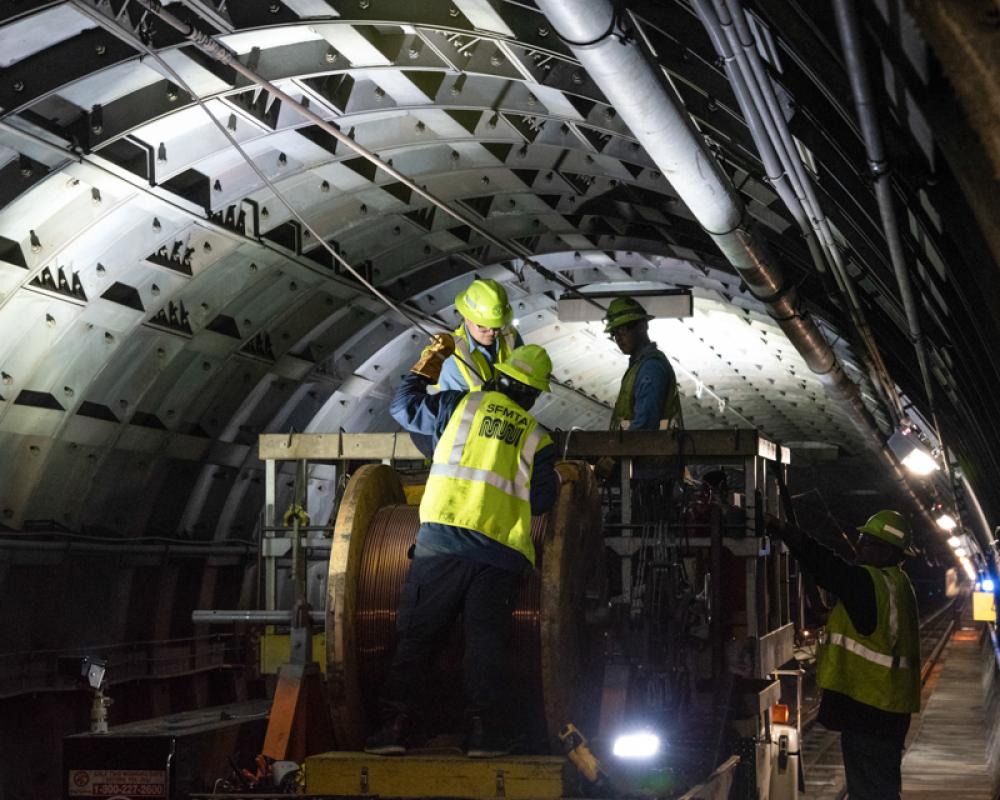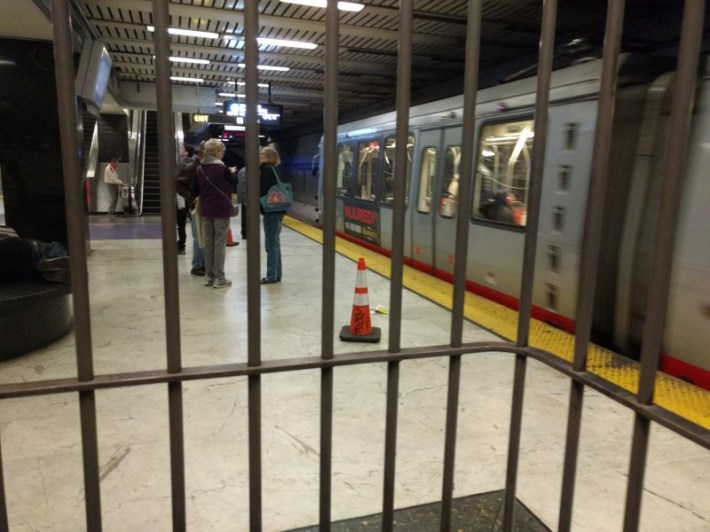WTF Muni!
5:11 PM PDT on April 29, 2019

A crew repairing the overhead wire on Friday. Photo: SFMTA
Note: GJEL Accident Attorneys regularly sponsors coverage on Streetsblog San Francisco and Streetsblog California. Unless noted in the story, GJEL Accident Attorneys is not consulted for the content or editorial direction of the sponsored content.
Early Friday morning, Muni's subway operations came to a halt. From the SFMTA's post on the incident:
At 6:33 a.m., the lines that provide the power to Muni light rail vehicles became detached between the Powell Street and Civic Center stations, causing a train to stall in the tunnel and halting train service from Church to Embarcadero.
It took about 13 hours to get trains running 'normally' again:
We know that this has been an exceptionally difficult week for Muni customers. Whether it’s been concerns over the safety of the new Siemens LRV4 trains, the ongoing operator shortage or today’s service delays, it has been a frustrating period to be sure.
Artist Roger Adkins put it beautifully:
https://twitter.com/Walter_Ringtail/status/1121886152934342656
Indeed: "Why is this always happening, get your act together Muni!"
Advocates who spoke with Streetsblog wanted to know why Muni didn't continue to run service on one track. They also wanted to know why it's got to be so hard to transfer between the systems on Market Street.
Most transit systems, when they have a breakdown on one track, are able to operate a restricted service in both directions on the remaining track. It causes delays and some rider confusion for sure, but it's not as bad as shutting down altogether.
Dennis Lytton, a Bay Area-based expert on train safety and operations, and a former Program Manager of Safety and Security at the American Public Transportation Association, told Streetsblog that when he "visited the Muni control center several years ago they explained to me that though the Market Street subway is capable of single tracking, they don't do it in response to an incident. They just turn trains back... I remember thinking how weird this was at the time." Streetsblog reached out to SFMTA for an explanation and will update accordingly.
Furthermore, "The pantograph and/or the wire is poorly maintained. Full stop," he added. That means breakdowns will happen frequently and Muni has left itself with no plan "B," except massive delays and crowded, unreliable replacement buses.
Advocates who spoke with Streetsblog all seemed to echo a similar theme: Friday's meltdown was less about a broken wire and more about a broken system. "Given the slew of problems with vehicles and operations over the past few weeks, this doesn't seem failure-as-usual," wrote Seamless Bay Area's Beaudry Kock, in an email to Streetsblog. Fixing Muni, he wrote, will "require the political class of San Francisco to face up to the fact that we are a transit-first city in theory [but] we do not make the financial investments or the political sacrifices needed to make it so in practice."
Kock argues that sacking SFMTA leadership is pointless because politics will keep real reformers far away. "No Andy Byford-type is going to take Ed Reiskin's job (no matter how much that might be needed) given the headwind the Muni leadership has to fight to get things done." [UPDATE: And it looks as if Reiskin is out]
The SF Transit riders expressed similar frustration:
https://twitter.com/SFTRU/status/1121861080945270784
Ian Griffiths, also of Seamless, wrote to Streetsblog that there's just no excuse for stranding riders the way the city did on Friday. "The Market Street corridor is one of highest capacity transit corridors in the Bay Area, and probably the country. It has six sets of rail tracks between Embarcadero and Civic Center, plus more than a dozen bus lines. Of course, that system needs to be operated in such a way that if there is a problem on one set of tracks or tires, other sets of tracks and tires traveling on the same corridor can pick up the slack."
To some extent this did happen--through a mutual-aid agreement, Muni passes were honored on BART, at least between the Embarcadero and Balboa Park.
"I’m glad BART opened the system to Muni riders. My experience as a BART director was that other transit agencies helped to the extent they could if you were having a particularly bad day. We have a lot of different agencies, and a lot of transportation bottlenecks, so robust mutual aid ought to be the norm," wrote Livable City's Tom Radulovich, in an email to Streetsblog, adding that "It should be better planned for, and MTC and the transit operators should strategically provide more ’slack’ in the transit network so it’s better able to recover and compensate when something goes down."
But Griffiths, again getting back to the over-arching governance and systemic problem still sees a big flaw--that only in the case of a complete meltdown can passengers use their fares on a parallel system.

BART and Muni stations seem designed to make transfers as difficult as possible (as with the above cage around the stairwell to BART, to make sure you can't step off and catch a Muni train). With the exception of Clipper, the systems are also electronically segregated: Alicia Trost, a spokesperson for BART, told Streetsblog that they don't even know how many Muni riders took BART on Friday, because of lack of common fare media and compatible gates.
"People should always be encouraged to hop between the most efficient, and reliable mode at any given time," wrote Griffiths. "If people are used to doing this on a daily basis, then in the event of a shutdown of part of the system, it won't be such a big deal."
Were you stuck in Friday's meltdown? Do you think this will be the last straw that will force the city to repair some of these systemic problems? Post your comments below.
Stay in touch
Sign up for our free newsletter
More from Streetsblog San Francisco
Commentary: Making Valencia Better for Business
Curbside protected bike lanes with curbside parklets deliver on much-needed economic benefits for merchants while ensuring safety for all




